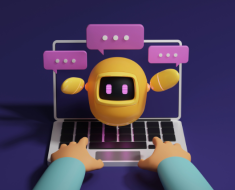BENGALURU: In a classroom in the southern Indian city of Bengaluru, half a dozen young students sit at a desk, listening intently to a small black device as a woman’s voice calls out simple sentences in English, that they then repeat carefully.
The device, an Amazon Echo Dot speaker, uses artificial intelligence-enabled voice recognition technology to help the students improve their reading, listening and speaking in English – for some their second language, for others their third.
In the municipal-funded school, the English language tool has helped dozens of first-generation learners gain in confidence and ability, said teacher Lingesh K, who goes by his first name.
“It is a new way of learning – the technology is novel for the kids, and they also find it entertaining,” said Lingesh, who has taught English in the school for two years, and has used the AI-enabled system, Tara, for the past year in his classes.
“Every child gets a chance to interact with the device. The technology is not a substitute for lesson, but it is a good complement,” he told the Thomson Reuters Foundation.
As advances in AI gather pace and the technology is increasingly used in areas from marketing, to law and surveillance, there is a big push by the Indian government and by tech firms to more firmly entrench it in education.
From helping teach English, to assisting teachers with lesson plans, to identifying pupils at risk of dropping out, AI tools are helping bridge learning gaps that widened in schools during the Covid-19 pandemic, tech and education experts said.
“The majority of schools in India don’t have the resources for high-tech solutions, and parents cannot afford additional tutoring support,” said Gowri Mahesh, a co-founder at Learning Matters, the edtech firm in Bengaluru that built Tara, which is used in about 200 schools in three Indian states.
“English language ability is one such gap. The solution needed to be light on hardware, accessible, affordable, non-judgmental and suitable for a range of requirements,” she said.
Customised approach
India’s landmark Right to Education Act, 2009 made education a fundamental right of every child aged six to 14, yet spending on education as a share of total GDP (gross domestic product) is less than 3% – among the lowest of developing nations.
There were some 267 million children enrolled in about 1.5 million schools nationwide last year, according to official data. Less than half the schools had a computer and just over a third had Internet access.
So startups, nonprofits and big tech firms are customising AI tools for specific environments and learning needs.
Faced with a large number of students dropping out, the southern state of Andhra Pradesh used a Microsoft AI system that compiled data on gender, academic performance and socio-economic metrics to predict potential dropouts, so they and their parents could be counselled.
While Sikshana Foundation, a nonprofit that aims to improve India’s state school system, focuses on easing the load of teachers who often handle several subjects and grades.
Last month, it introduced an AI-enabled bot named Shiksha – meaning education in Hindi – developed by Microsoft Research, which helps teachers create lesson plans, student activities and assessments. It also responds to queries.
About 30 teachers use the English-language bot in southern Karnataka state, with plans to extend it nationwide, and add regional languages, said Smitha Venkatesh, a technology advisor at Sikshana Foundation.
The bot can help teachers save up to 75% of the time they would otherwise spend on lesson plans and assignments, she said.
“Even in small village schools, teachers are trying their best to incorporate technology, but they don’t have the resources,” said Kalika Bali, principal researcher at Microsoft Research India, who was named among the 100 most influential people in AI by Time magazine this year.
“It’s the teachers we have to empower, it’s the teaching system we have to build up,” she added.
Privacy fears
The introduction of ChatGPT in November 2022 accelerated the adoption of generative AI in education, with some welcoming its ease of use, while others worried about plagiarism, misinformation and inbuilt cultural bias.
But while the technology has the potential to transform education, it can also widen inequities and disparities, warned Libing Wang at the UN cultural agency (UNESCO), which has set a framework for generative AI use in education.
“The potential of generative AI in education is significant, but requires a comprehensive, nuanced and rights-based approach,” said Wang.
“We should avoid a naive ‘technological solutionism’ belief – AI will not and cannot solve all our problems, including those in education.”
There are fears about the misuse of student data in India, where AI-enabled facial recognition systems have been installed in schools for checking attendance and for safety purposes, despite concerns about privacy.
There have been reports – including by Human Rights Watch – of leaks of data on millions of students and teachers collected by state education app Diksha, which can also track their locations.
The government has not commented on these reports.
As AI is used in more Indian classrooms, more student data will be collected, yet there are few guardrails to protect the data from misuse, said Prateek Waghre, executive director at Internet Freedom Foundation, a digital rights group.
“It is not clear what data is being collected, how it will be used, and if there will be a meaningful consent mechanism for students and parents to have a say in this, or to opt out,” he said.
“While we have a personal data protection law, we don’t know how it will be enforced. And when AI in education is sold as a part of the broader digital public infrastructure, that law won’t really apply,” Waghre said.
The IT Ministry and the Education Ministry did not respond to requests for comment.
In Bengaluru, Learning Matters – which applies privacy protections for data collected by Tara – has made English lessons fun for 13-year-old Chetan, the son of a construction worker.
“I like talking to Tara, learning new words and sentences,” he said. “I also like my teacher. So I would like to have my teacher and Tara.” – Thomson Reuters Foundation




